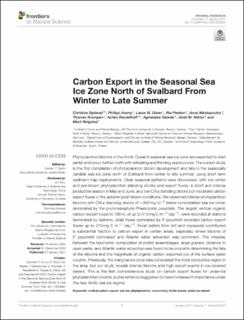| dc.description.abstract | Phytoplankton blooms in the Arctic Ocean's seasonal sea ice zone are expected to start earlier and occur further north with retreating and thinning sea ice cover. The current study is the first compilation of phytoplankton bloom development and fate in the seasonally variable sea ice zone north of Svalbard from winter to late summer, using short-term sediment trap deployments. Clear seasonal patterns were discovered, with low winter and pre-bloom phytoplankton standing stocks and export fluxes, a short and intense productive season in May and June, and low Chl a standing stocks but moderate carbon export fluxes in the autumn post-bloom conditions. We observed intense phytoplankton blooms with Chl a standing stocks of >350 mg m−2 below consolidated sea ice cover, dominated by the prymnesiophyte Phaeocystis pouchetii. The largest vertical organic carbon export fluxes to 100 m, of up to 513 mg C m−2 day−1, were recorded at stations dominated by diatoms, while those dominated by P. pouchetii recorded carbon export fluxes up to 310 mg C m−2 day−1. Fecal pellets from krill and copepods contributed a substantial fraction to carbon export in certain areas, especially where blooms of P. pouchetii dominated and Atlantic water advection was prominent. The interplay between the taxonomic composition of protist assemblages, large grazers, distance to open water, and Atlantic water advection was found to be crucial in determining the fate of the blooms and the magnitude of organic carbon exported out of the surface water column. Previously, the marginal ice zone was considered the most productive region in the area, but our study reveals intense blooms and high export events in ice-covered waters. This is the first comprehensive study on carbon export fluxes for under-ice phytoplankton blooms, a phenomenon suggested to have increased in importance under the new Arctic sea ice regime. | en_US |
